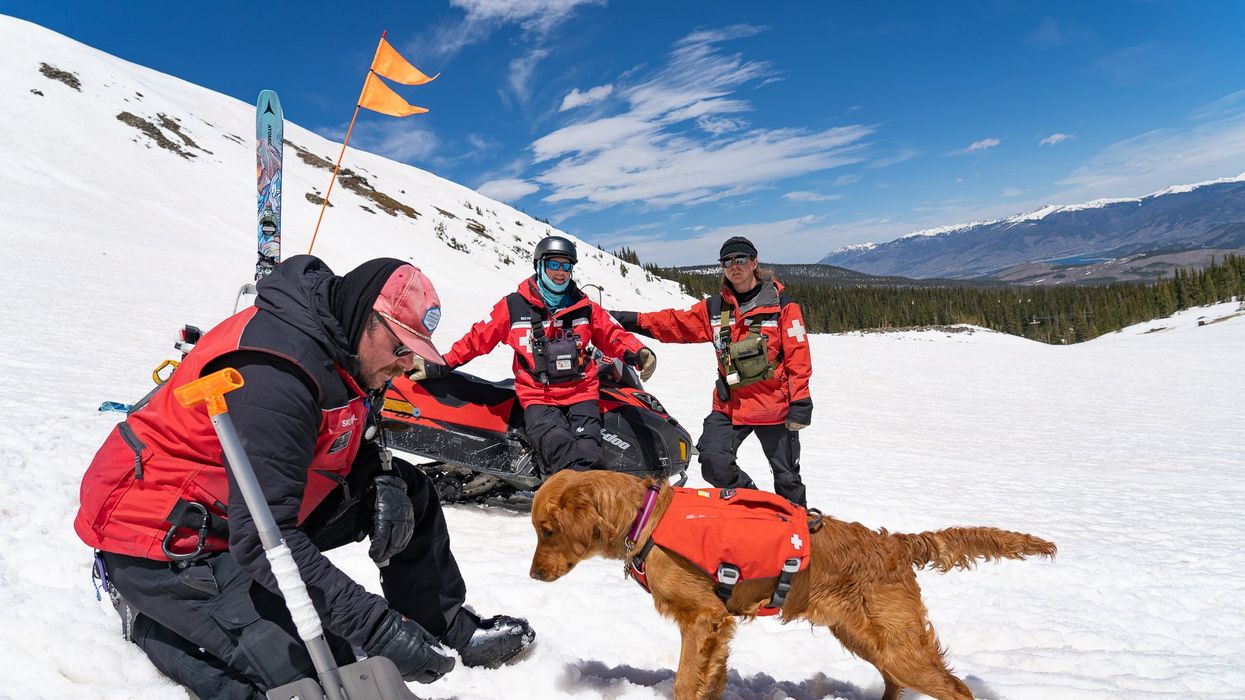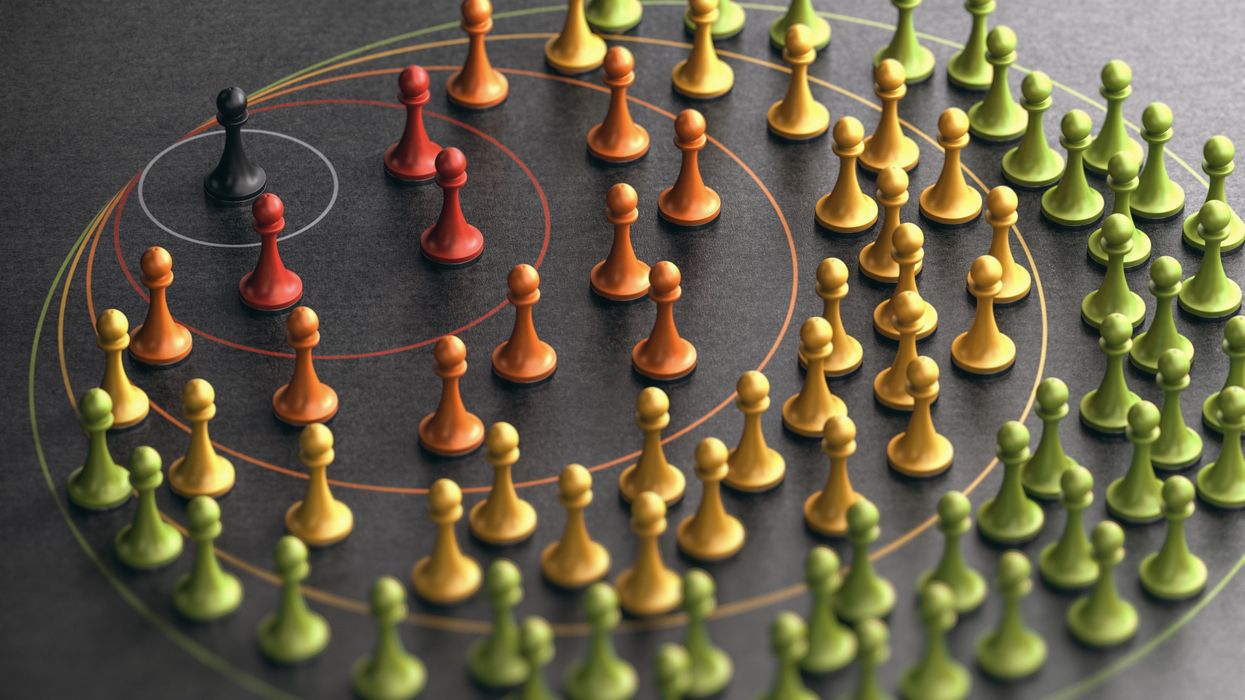Want to Strengthen American Democracy? The Science of Collaboration Can Help
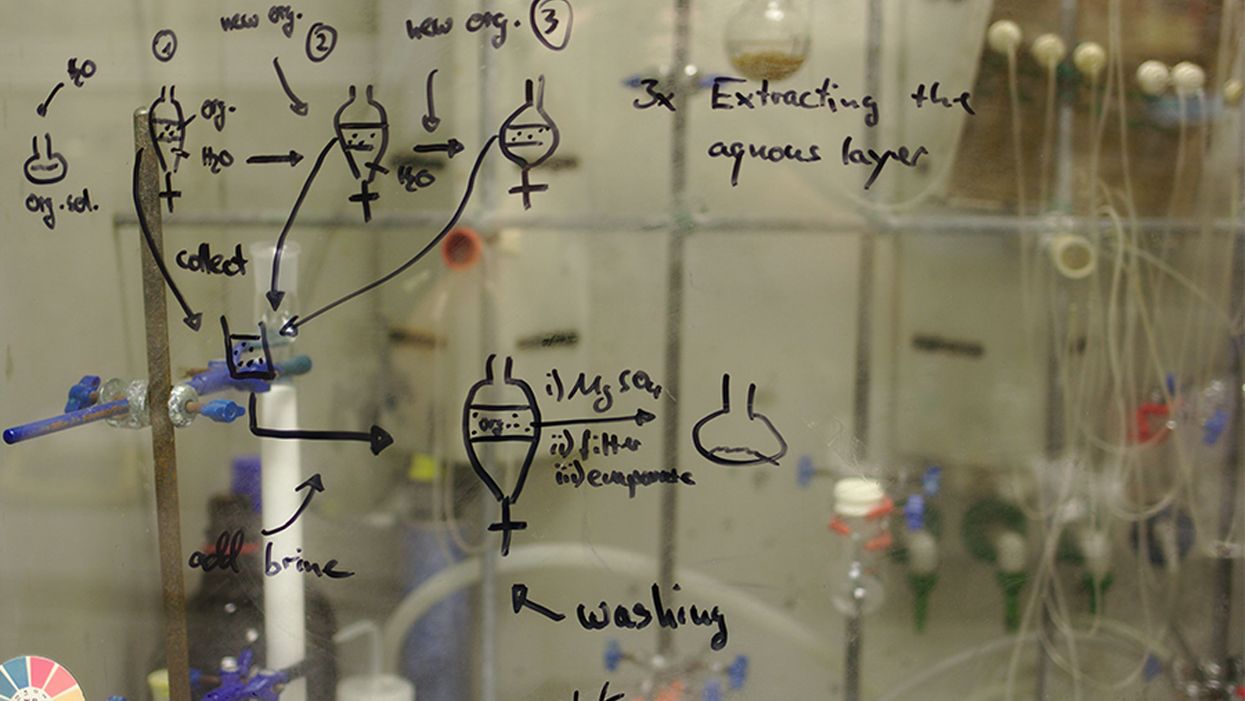
The science of collaboration explores why diverse individuals choose to work together and how to design systems that encourage successful collaborations.
This article is part of the magazine, "The Future of Science In America: The Election Issue," co-published by LeapsMag, the Aspen Institute Science & Society Program, and GOOD.
American politics has no shortage of ailments. Many do not feel like their voice matters amid the money and influence amassed by corporations and wealthy donors. Many doubt whether elected officials and bureaucrats can or even want to effectively solve problems and respond to citizens' needs. Many feel divided both physically and psychologically, and uncomfortable (if not scared) at the prospect of building new connections across lines of difference.
Strengthening American democracy requires countering these trends. New collaborations between university researchers and community leaders such as elected officials, organizers, and nonprofit directors can help. These collaborations can entail everything from informal exchanges to co-led projects.
But there's a catch. They require that people with diverse forms of knowledge and lived experience, who are often strangers, choose to engage with one another. We know that strangers often remain strangers.
That's why a science of collaboration that centers the inception question is vital: When do diverse individuals choose to work together in the first place? How can we design institutions that encourage beneficial collaborations to arise and thrive? And what outcomes can occur?
How Collaborations Between Researchers and Community Leaders Can Help
First consider the feeling of powerlessness. Individual action becomes more powerful when part of a collective. For ordinary citizens, voting and organizing are arguably the two most impactful forms of collective action, and as it turns out there is substantial research on how to increase turnout and how to build powerful civic associations. Collaborations between researchers familiar with that work and organizers and nonprofit leaders familiar with a community's context can be especially impactful.
For example, in 2019, climate organizers with a nonpartisan group in North Carolina worked with a researcher who studies organizing to figure out how to increase volunteer commitment—that is, how to transform volunteers who only attend meetings into leaders who take responsibility for organizing others. Together, they designed strategies that made sense for the local area. Once implemented, these strategies led to a 161% year-over-year increase in commitment. More concretely, dozens of newly empowered volunteers led events to raise awareness of how climate change was impacting the local community and developed relationships with local officials and business owners, all while coming to see themselves as civic leaders. This experience also fed back into the researcher's work, motivating the design of future studies.
Or consider how researchers and local elected officials can collaborate and respond to novel challenges like the coronavirus. For instance, in March 2020, one county in Upstate New York suddenly had to figure out how to provide vital services like internet and health screenings for residents who could no longer visit shuttered county offices. They turned to a researcher who knew about research on mobile vans. Together, they spoke about the benefits and costs of mobile vans in general, and then segued into a more specific conversation about what routings and services would make sense in this specific locale. Their collaboration entailed a few conversations leading up to the county's decision, and in the end the county received helpful information and the researcher learned about new implementation challenges associated with mobile vans.
In April, legislators in another Upstate New York county realized they needed honest, if biting, feedback from local mayors about their response to the pandemic. They collaborated with researchers familiar with survey methodology. County legislators supplied the goals and historical information about fraught county–city relationships, while researchers supplied evidence-based techniques for conducting interviews in delicate contexts. These interviews ultimately revealed mayors' demand for more up-to-date coronavirus information from the county and also more county-led advocacy at the state level.
To be sure, there are many situations in which elected officials' lack of information is not the main hurdle. Rather, they need an incentive to act. Yet this is another situation in which collaborations between university researchers and community leaders focused on evidence-based, context-appropriate approaches to organizing and voter mobilization could produce needed pressure.
This brings me to the third way in which collaborations between researchers and community leaders can strengthen American democracy. They entail diverse people working to develop a common interest by building new connections across lines of difference. This is a core democratic skill that withers in the absence of practice.
In addition to credibility, we've learned that potential collaborators also care about whether others will be responsive to their goals and constraints, understand their point of view, and will be enjoyable to interact with.
The Science of Collaboration
The previous examples have one thing in common: a collaboration actually took place.
Yet that often does not happen. While there are many reasons why collaborations between diverse people should arise we know far less about when they actually do arise.
This is why a science of collaboration centered on inception is essential. Some studies have already revealed new insights. One thing we've learned is that credibility is important, but often not enough. By credibility, I mean that people are more likely to collaborate when they perceive each other to be trustworthy and have useful information or skills to share. Potential collaborators can signal their credibility by, for instance, identifying shared values and mentioning relevant previous experiences. One study finds that policymakers are more interested in collaborating with researchers who will share findings that are timely and locally relevant—that is, the kind that are most useful to them.
In addition to credibility, we've learned that potential collaborators also care about whether others will be responsive to their goals and constraints, understand their point of view, and will be enjoyable to interact with. For instance, potential collaborators can explicitly acknowledge that they know the other person is busy, or start with a question rather than a statement to indicate being interested. One study finds that busy nonprofit leaders are more likely to collaborate with researchers who explicitly state that (a) they are interested in learning about the leaders' expertise, and (b) they will efficiently share what they know. Another study underscores that potential collaborators need to feel like they know how to interact—that is, to feel like they have a "script" for what's appropriate to say during the interaction.
We're also learning that institutions (such as matchmaking organizations) can reduce uncertainty about credibility and relationality, and also help collaborations start off on the right foot. They are a critical avenue for connecting strangers. For instance, brokers can use techniques that increase the likelihood that diverse people feel comfortable sharing what they know, raising concerns, and being responsive to others.
Looking Ahead
A science of collaboration that centers the inception question is helpful on two levels. First, it provides an evidence base for how to effectively connect diverse people to work together. Second, when applied to university researchers and community leaders, it can produce collaborations that strengthen American democracy. Moreover, these collaborations are easily implemented, especially when informal and beginning as a conversation or two (as in the mobile vans example).
Existing research on the science of collaboration has already yielded actionable insights, yet we still have much to learn. For instance, we need to better understand the latent demand. Interviews that ask a wide variety of community leaders and researchers who have not previously collaborated to talk about why doing so might be helpful would be enlightening. They could also be a useful antidote to the narrative of conflict that often permeates discussions about the role of science in American politics.
In addition, we need to learn more about the downstream consequences of these collaborations, such as whether new networks arise that include colleagues of the initial collaborators. Here, it would be helpful to study the work of brokers – how they introduce people to each other, how much they follow up, and the impact of those decisions.
Ultimately, expanding the evidence base of the science of collaboration, and then directly applying what we learn, will provide important new and actionable avenues for strengthening American democracy.
[Editor's Note: To read other articles in this special magazine issue, visit the beautifully designed e-reader version.]
Avalanche rescue dogs train to find and dig out people buried in snow slides
Two-and-a-half year-old Huckleberry, a blue merle Australian shepherd, pulls hard at her leash; her yelps can be heard by skiers and boarders high above on the chairlift that carries them over the ski patrol hut to the top of the mountain. Huckleberry is an avalanche rescue dog — or avy dog, for short. She lives and works with her owner and handler, a ski patroller at Breckenridge Ski Resort in Colorado. As she watches the trainer play a game of hide-and-seek with six-month-old Lume, a golden retriever and avy dog-in-training, Huckleberry continues to strain on her leash; she loves the game. Hide-and-seek is one of the key training methods for teaching avy dogs the rescue skills they need to find someone caught in an avalanche — skier, snowmobiler, hiker, climber.
Lume’s owner waves a T-shirt in front of the puppy. While another patroller holds him back, Lume’s owner runs away and hides. About a minute later — after a lot of barking — Lume is released and commanded to “search.” He springs free, running around the hut to find his owner who reacts with a great amount of excitement and fanfare. Lume’s scent training will continue for the rest of the ski season (Breckenridge plans operating through May or as long as weather permits) and through the off-season. “We make this game progressively harder by not allowing the dog watch the victim run away,” explains Dave Leffler, Breckenridge's ski patroller and head of the avy dog program, who has owned, trained and raised many of them. Eventually, the trainers “dig an open hole in the snow to duck out of sight and gradually turn the hole into a cave where the dog has to dig to get the victim,” explains Leffler.
By the time he is three, Lume, like Huckleberry, will be a fully trained avy pup and will join seven other avy dogs on Breckenridge ski patrol team. Some of the team members, both human and canine, are also certified to work with Colorado Rapid Avalanche Deployment, a coordinated response team that works with the Summit County Sheriff’s office for avalanche emergencies outside of the ski slopes’ boundaries.
There have been 19 avalanche deaths in the U.S. this season, according to avalanche.org, which tracks slides; eight in Colorado. During the entirety of last season there were 17. Avalanche season runs from November through June, but avalanches can occur year-round.
High tech and high stakes
Complementing avy dogs’ ability to smell people buried in a slide, avalanche detection, rescue and recovery is becoming increasingly high tech. There are transceivers, signal locators, ground scanners and drones, which are considered “games changers” by many in avalanche rescue and recovery
For a person buried in an avalanche, the chance of survival plummets after 20 minutes, so every moment counts.
A drone can provide thermal imaging of objects caught in a slide; what looks like a rock from far away might be a human with a heat signature. Transceivers, also known as beacons, send a signal from an avalanche victim to a companion. Signal locators, like RECCO reflectors which are often sewn directly into gear, can echo back a radar signal sent by a detector; most ski resorts have RECCO detector units.
Research suggests that Ground Penetrating Radar (GPR), an electromagnetic tool used by geophysicists to pull images from inside the ground, could be used to locate an avalanche victim. A new study from the Department of Energy’s Sandia National Laboratories suggests that a computer program developed to pinpoint the source of a chemical or biological terrorist attack could also be used to find someone submerged in an avalanche. The search algorithm allows for small robots (described as cockroach-sized) to “swarm” a search area. Researchers say that this distributed optimization algorithm can help find avalanche victims four times faster than current search mechanisms. For a person buried in an avalanche, the chance of survival plummets after 20 minutes, so every moment counts.
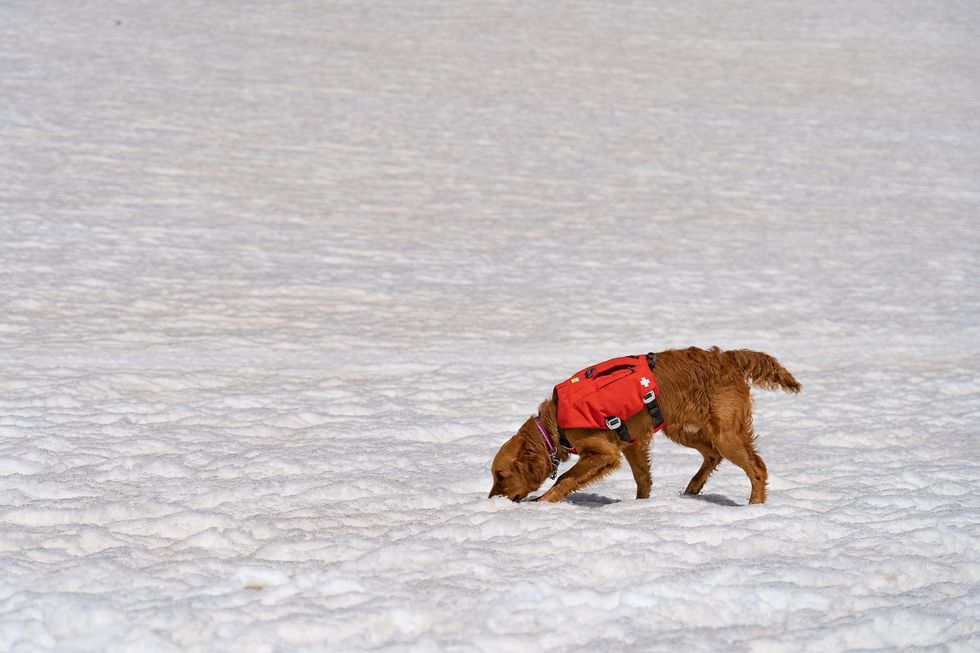
An avy dog in training is picking up scent
Sarah McLear
While rescue gear has been evolving, predicting when a slab will fall remains an emerging science — kind of where weather forecasting science was in the 1980s. Avalanche forecasting still relies on documenting avalanches by going out and looking,” says Ethan Greene, director of the Colorado Avalanche Information Center (CAIC). “So if there's a big snowstorm, and as you might remember, most avalanches happened during snowstorms, we could have 10,000 avalanches that release and we document 50,” says Greene. “Avalanche forecasting is essentially pattern recognition,” he adds--and understanding the layering structure of snow.
However, determining where the hazards lie can be tricky. While a dense layer of snow over a softer, weaker layer may be a recipe for an avalanche, there’s so much variability in snowpack that no one formula can predict the trigger. Further, observing and measuring snow at a single point may not be representative of all nearby slopes. Finally, there’s not enough historical data to help avalanche scientists create better prediction models.
That, however, may be changing.
Last year, an international group of researchers created computer simulations of snow cover using 16 years of meteorological data to forecast avalanche hazards, publishing their research in Cold Regions Science and Technology. They believe their models, which categorize different kinds of avalanches, can support forecasting and determine whether the avalanche is natural (caused by temperature changes, wind, additional snowfall) or artificial (triggered by a human or animal).
With smell receptors ranging from 800 million for an average dog, to 4 billion for scent hounds, canines remain key to finding people caught in slides.
With data from two sites in British Columbia and one in Switzerland, researchers built computer simulations of five different avalanche types. “In terms of real time avalanche forecasting, this has potential to fill in a lot of data gaps, where we don't have field observations of what the snow looks like,” says Simon Horton, a postdoctoral fellow with the Simon Fraser University Centre for Natural Hazards Research and a forecaster with Avalanche Canada, who participated in the study. While complex models that simulate snowpack layers have been around for a few decades, they weren’t easy to apply until recently. “It's been difficult to find out how to apply that to actual decision-making and improving safety,” says Horton. If you can derive avalanche problem types from simulated snowpack properties, he says, you’ll learn “a lot about how you want to manage that risk.”
The five categories include “new snow,” which is unstable and slides down the slope, “wet snow,” when rain or heat makes it liquidly, as well as “wind-drifted snow,” “persistent weak layers” and “old snow.” “That's when there's some type of deeply buried weak layer in the snow that releases without any real change in the weather,” Horton explains. “These ones tend to cause the most accidents.” One step by a person on that structurally weak layer of snow will cause a slide. Horton is hopeful that computer simulations of avalanche types can be used by scientists in different snow climates to help predict hazard levels.
Greene is doubtful. “If you have six slopes that are lined up next to each other, and you're going to try to predict which one avalanches and the exact dimensions and what time, that's going to be really hard to do. And I think it's going to be a long time before we're able to do that,” says Greene.
What both researchers do agree on, though, is that what avalanche prediction really needs is better imagery through satellite detection. “Just being able to count the number of avalanches that are out there will have a huge impact on what we do,” Greene says. “[Satellites] will change what we do, dramatically.” In a 2022 paper, scientists at the University of Aberdeen in England used satellites to study two deadly Himalayan avalanches. The imaging helped them determine that sediment from a 2016 ice avalanche plus subsequent snow avalanches contributed to the 2021 avalanche that caused a flash flood, killing over 200 people. The researchers say that understanding the avalanches characteristics through satellite imagery can inform them how one such event increases the magnitude of another in the same area.
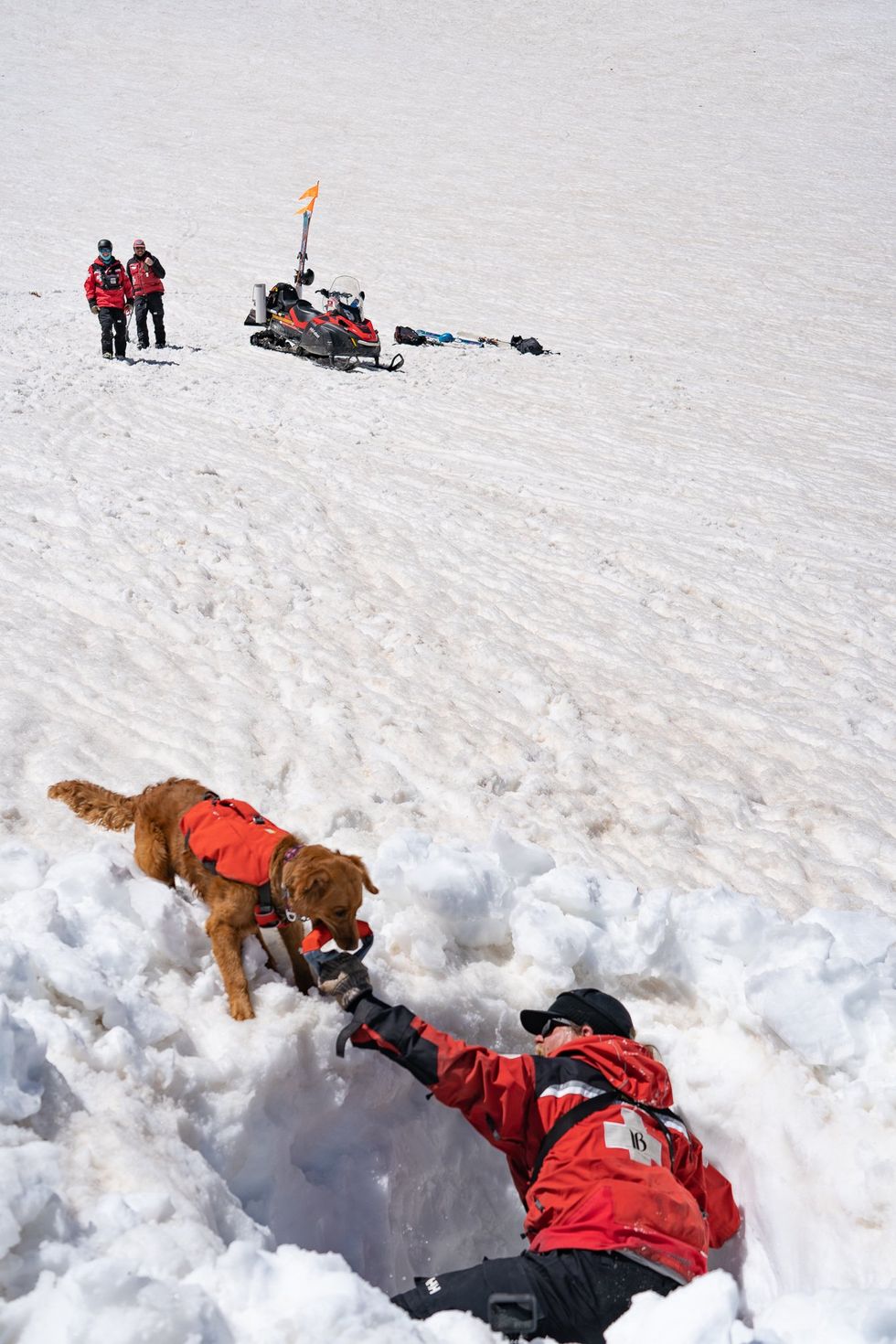
Avy dogs trainers hide in dug-out holes in the snow, teaching the dogs to find buried victims
Sarah McLear
Lifesaving combo: human tech and Mother Nature’s gear
Even as avalanche forecasting evolves, dogs with their built-in rescue mechanisms will remain invaluable. With smell receptors ranging from 800 million for an average dog, to 4 billion for scent hounds, canines remain key to finding people caught in slides. (Humans in comparison, have a meager 12 million.) A new study published in the Journal of Neuroscience revealed that in dogs smell and vision are connected in the brain, which has not been found in other animals. “They can detect the smell of their owner's fingerprints on a glass slide six weeks after they touched it,” says Nicholas Dodman, professor emeritus at Cummings School of Veterinary Medicine at Tufts University. “And they can track from a boat where a box filled with meat was buried in the water, 100 feet below,” says Dodman, who is also co-founder and president of the Center for Canine Behavior Studies.
Another recent study from Queens College in Belfast, United Kingdom, further confirms that dogs can smell when humans are stressed. They can also detect the smell of a person’s breath and the smell of the skin cells of a deceased person.
The emerging avalanche-predicting human-made tech and the incredible nature-made tech of dogs’ olfactory talents is the lifesaving “equipment” that Leffler believes in. Even when human-made technology develops further, it will be most efficient when used together with the millions of dogs’ smell receptors, Leffler believes. “It is a combination of technology and the avalanche dog that will always be effective in finding an avalanche victim.”
Living with someone changes your microbiome, new research shows
For the first time, research has shown that bacteria of the microbiome are transmitted between many individuals, not just infants and their mothers, in ways that can’t be explained by having the same diet or geography.
Some roommate frustration can be expected, whether it’s a sink piled high with crusty dishes or crumbs where a clean tabletop should be. Now, research suggests a less familiar issue: person-to-person transmission of shared bacterial strains in our gut and oral microbiomes. For the first time, the lab of Nicola Segata, a professor of genetics and computational biology at the University of Trento, located in Italy, has shown that bacteria of the microbiome are transmitted between many individuals, not just infants and their mothers, in ways that can’t be explained by their shared diet or geography.
It’s a finding with wide-ranging implications, yet frustratingly few predictable outcomes. Our microbiomes are an ever-growing and changing collection of helpful and harmful bacteria that we begin to accumulate the moment we’re born, but experts are still struggling to unravel why and how bacteria from one person’s gut or mouth become established in another person’s microbiome, as opposed to simply passing through.
“If we are looking at the overall species composition of the microbiome, then there is an effect of age of course, and many other factors,” Segata says. “But if we are looking at where our strains are coming from, 99 percent of them are only present in other people’s guts. They need to come from other guts.”
If we could better understand this process, we might be able to control and use it; perhaps hospital patients could avoid infections from other patients when their microbiome is depleted by antibiotics and their immune system is weakened, for example. But scientists are just beginning to link human microbiomes with various ailments. Growing evidence shows that our microbiomes steer our long-term health, impacting conditions like obesity, irritable bowel syndrome, type 2 diabetes, and cancer.
Previous work from Segata’s lab and others illuminated the ways bacteria are passed from mothers to infants during the first few months of life during vaginal birth, breastfeeding and other close contact. And scientists have long known that people in close proximity tend to share bacteria. But the factors related to that overlap, such as genetics and diet, were unclear, especially outside the mother-baby dyad.
“If we look at strain sharing between a mother and an infant at five years of age, for example, we cannot really tell which was due to transmission at birth and which is due to continued transmission because of contact,” Segata says. Experts hypothesized that they could be caused by bacterial similarities in the environment itself, genetics, or bacteria from shared foods that colonized the guts of people in close contact.
Strain sharing was highest in mother-child pairs, with 96 percent of them sharing strains, and only slightly lower in members of shared households, at 95 percent.
In Italy, researchers led by Mireia Valles-Colomer, including Segata, hoped to unravel this mystery. They compared data from 9,715 stool and saliva samples in 31 genomic datasets with existing metadata. Scientists zoomed in on variations in each bacterial strain down to the individual level. They examined not only mother-child pairs, but people living in the same household, adult twins, and people living in the same village in a level of detail that wasn’t possible before, due to its high cost and difficulties in retrieving data about interactions between individuals, Segata explained.
“This paper is, with high granularity, quantifying the percent sharing that you expect between different types of social interactions, controlling for things like genetics and diet,” Gibbons says. Strain sharing was highest in mother-child pairs, with 96 percent of them sharing strains, and only slightly lower in members of shared households, at 95 percent. And at least half of the mother-infant pairs shared 30 percent of their strains; the median was 12 percent among people in shared households. Yet, there was no sharing among eight percent of adult twins who lived separately, and 16 percent of people within villages who resided in different households. The results were published in Nature.
It’s not a regional phenomenon. Although the types of bacterial strains varied depending on whether people lived in western and eastern nations — datasets were drawn from 20 countries on five continents — the patterns of sharing were much the same. To establish these links, scientists focused on individual variations in shared bacterial strains, differences that create unique bacterial “fingerprints” in each person, while controlling for variables like diet, demonstrating that the bacteria had been transmitted between people and were not the result of environmental similarities.
The impact of this bacterial sharing isn’t clear, but shouldn’t be viewed with trepidation, according to Sean Gibbons, a microbiome scientist at the nonprofit Institute for Systems Biology.
“The vast majority of these bugs are actually either benign or beneficial to our health, and the fact that we're swapping and sharing them and that we can take someone else's strain and supplement or better diversify our own little garden is not necessarily a bad thing,” he says.
"There are hundreds of billions of dollars of investment capital moving into these microbiome therapeutic companies; bugs as drugs, so to speak,” says Sean Gibbons, a microbiome scientist at the Institute for Systems Biology.
Everyday habits like exercising and eating vegetables promote a healthy, balanced gut microbiome, which is linked to better metabolic and immune function, and fewer illnesses. While many people’s microbiomes contain bacteria like C. diff or E. coli, these bacteria don’t cause diseases in most cases because they’re present in low levels. But a microbiome that’s been wiped out by, say, antibiotics, may no longer keep these bacteria in check, allowing them to proliferate and make us sick.
“A big challenge in the microbiome field is being able to rationally predict whether, if you're exposed to a particular bug, it will stick in the context of your specific microbiome,” Gibbons says.
Gibbons predicts that explorations of microbe-based therapeutics will be “exploding” in the coming decades. “There are hundreds of billions of dollars of investment capital moving into these microbiome therapeutic companies; bugs as drugs, so to speak,” he says. Rather than taking a mass-marketed probiotic, a precise understanding of an individual’s microbiome could help target the introduction of just the right bacteria at just the right time to prevent or treat a particular illness.
Because the current study did not differentiate between different types of contact or relationships among household members sharing bacterial strains or determine the direction of transmission, Segata says his current project is examining children in daycare settings and tracking their microbiomes over time to understand the role genetics and everyday interactions play in the level of transmission that occurs.
This relatively newfound ability to trace bacterial variants to minute levels has unlocked the chance for scientists to untangle when and how bacteria leap from one microbiome to another. As researchers come to better understand the factors that permit a strain to establish itself within a microbiome, they could uncover new strategies to control these microbes, harnessing the makeup of each microbiome to help people to resist life-altering medical conditions.
